Learn all the fun kangaroo facts for kids!

The kangaroo is a marsupial that is indigenous to Australia. As of 2015, there are 44 million kangaroos in Australia.
Male kangaroos are called bucks, boomers, jacks, or old men; females are does, flyers, or jills; and the young ones are joeys. A group of kangaroos is called a mob, troop, or court.
Physical Description
Kangaroos possess powerful hind legs with large feet, a long, strong tail, and small forelegs. The second and third claw on their hind limbs are fused together giving them a special claw for grooming their short, soft coats.
Their forelegs are dexterous and are used for eating, grooming, and defense. Kangaroos use their strong tails for balance while jumping. They are the tallest of all marsupials, standing between 5 and 6 feet (2 meters) tall from their feet to their long, pointed ears.
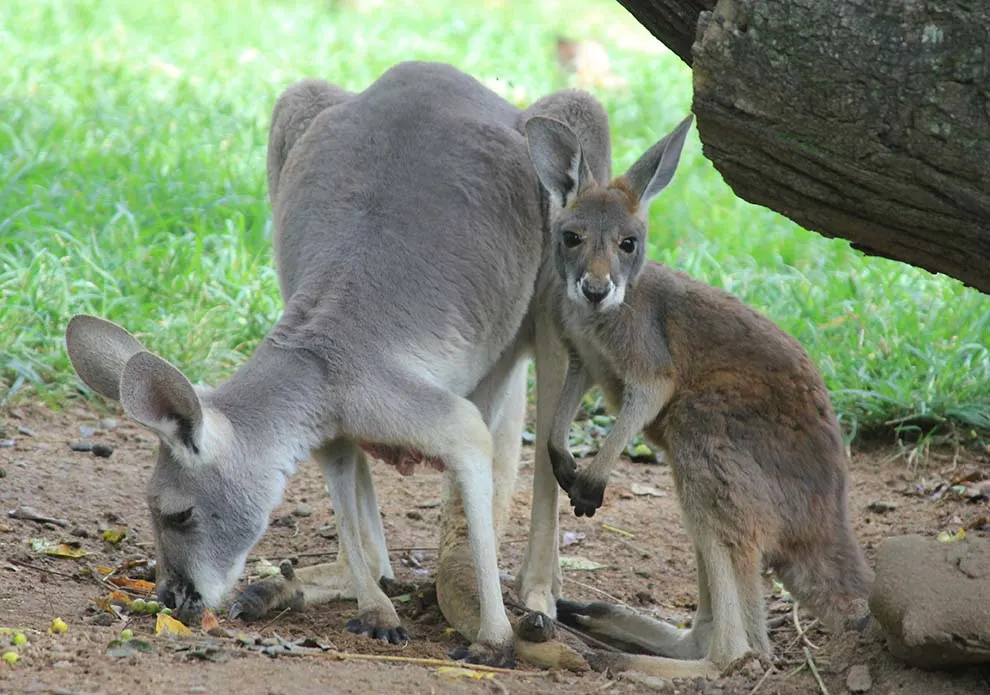
An adult kangaroo weighs between 50 to 120 pounds. Male kangaroos are taller and heavier than female kangaroos.
Kangaroos get around by jumping, using their strong legs and big feet to propel themselves along.
Kangaroos also have excellent hearing and can swivel their ears in all directions to pick up sounds. They have good eyesight but only respond to moving objects.
Habitat
Kangaroos live in Eastern Australia where the climate is dry and warm. They live in small, typically made up of 50 or more animals.
There are different types of kangaroos living in different parts of Australia. They can be found in rainforests, forests and woodlands. Depending on the kangaroo species it may make its homes on the floor or in the trees.
Habits of Kangaroos
Kangaroos are the only large animals to use hopping as a means of locomotion. Hopping is a fast, energy-efficient method of travel allowing kangaroos to cover large distances in search of food and water. They can hop or jump as far as about three times their own height.
The comfortable hopping speed for a red kangaroo is about 12–16 mph (20–25 km/h), but speeds of up to 43 mph (70 km/h) can be attained over short distances, while it can sustain a speed of 25 mph (40 km/h) for nearly 1.2 miles (2 km). At slow speeds, it uses its tail to form a tripod with its two forelimbs while bringing its hind feet forward.
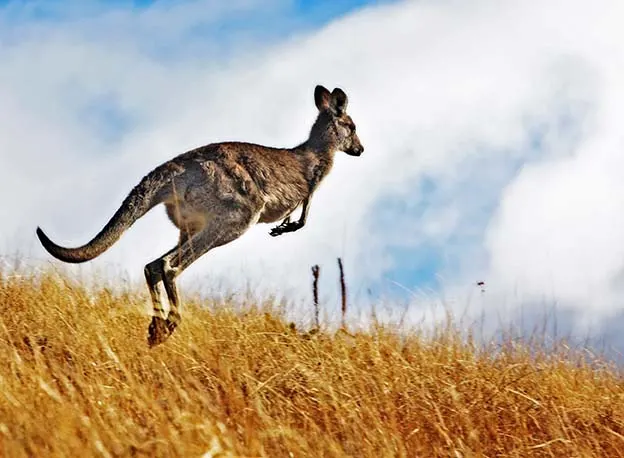
Kangaroos can be dangerous because of their powerful legs. They can lean back on their tails to deliver powerful kicks. Kangaroos also box. They hold each other with their front legs and kick each other with their powerful hind legs. Kangaroos can also balance on their strong tails and use both hind legs to kick their opponents at the same time.
Kangaroos communicate through noises like grunting, coughing, hissing, clicking or clucking.
What Do Kangaroos Eat?
The kangaroo is an herbivore. They mainly eat grass, but some species also eat shrubs. Kangaroos eat early in the morning or late in the afternoon. The kangaroo has developed specialized teeth that are rare amongst mammals to accommodate their grazing. Kangaroos chew their food, spit it up, and then re-chew it before it is completely digested, similar to how cows eat.
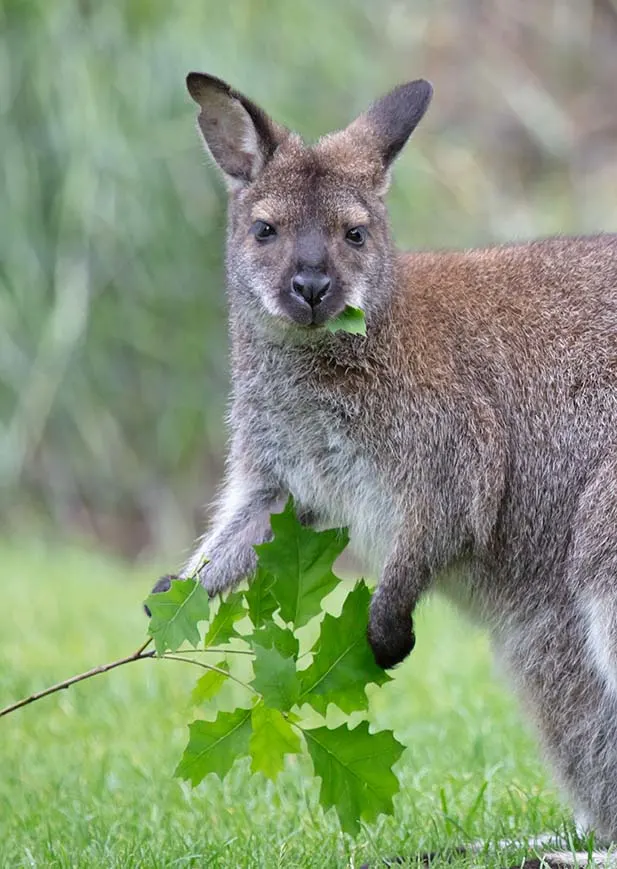
Offspring
Kangaroos have a polygynous mating system. A male will mate with several different females but a female will usually only mate with a single male.
Kangaroos gestate for about five weeks, after which they usually give birth to a single baby, called a joey. A female kangaroo can become pregnant again while a joey is still in her pouch.
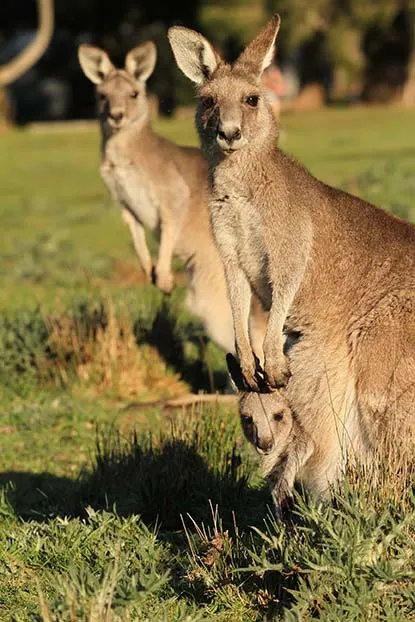
The younger joey will remain in a dormant state until the pouch is vacant. Once the older sibling leaves her pouch, the mother's body sends hormonal signals to resume the younger joey's development.
Kangaroos are marsupials because they carry their young in a special pouch on their bodies. Female kangaroos have a pouch on their belly, made by a fold in the skin, to cradle their joeys. Newborn joeys are just one inch long (2.5 centimeters) at birth, or about the size of a grape.
After they are born, joeys travel, unassisted, through their mother’s thick fur to the comfort and safety of the pouch. A newborn joey can’t suckle or swallow, so the kangaroo mom uses her muscles to pump milk down its throat. After about 4 months, the joey will emerge from the pouch for short trips and to graze on grass and small shrubs. At 10 months, the joey is mature enough to leave the pouch for good.
Classification/Taxonomy
Kingdom: Animalia
Phylum: Chordata
Class: Mammalia
Order: Diprotodontia
Family: Macropodidae
There are four species of kangaroos:
The Red Kangaroo (Macropus rufus) is the largest marsupial in the world.
The Eastern Grey Kangaroo (Macropus giganteus) is less well-known than the red but quite common.
The Western Grey Kangaroo (Macropus fuliginosus) is slightly smaller than the Eastern Grey and is found in the south part of Western Australia, South Australia near the coast, and the Darling River basin.
The Antilopine Kangaroo (Macropus antilopinus) is similar to the Eastern and Western Greys. They live on the grassy plains and woodlands in large groups.
There are about 50 other smaller macropods in the macropodidae family.
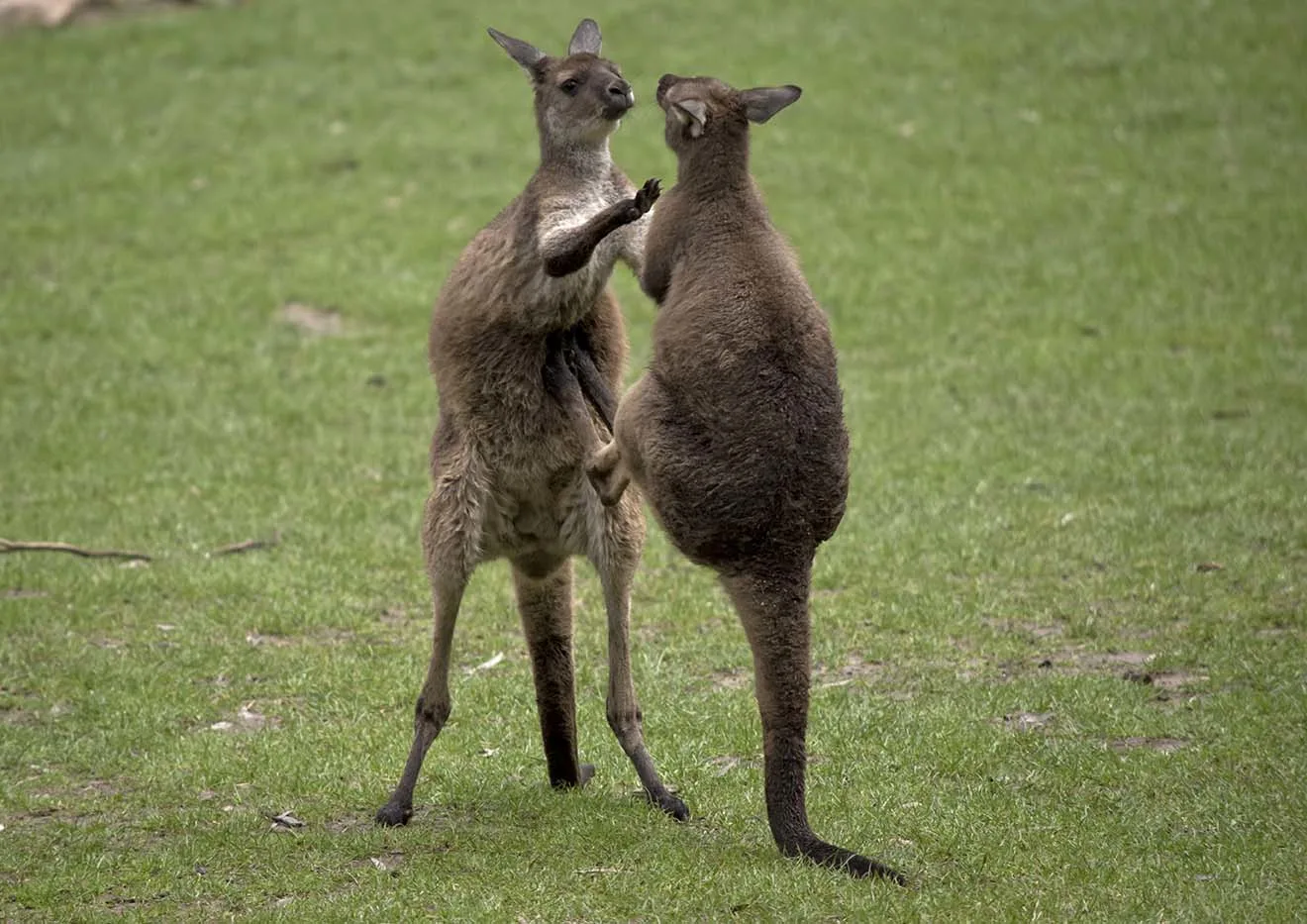
History of the Kangaroo
The Cookeroo bulwidarri, dated to about 23 million years ago, and Cookeroo hortusensis, which lived between 18 million and 20 million years ago. About 20 million years ago, tiny ancestors of modern kangaroos and a related group of kangaroos with fangs lived in dense forests in northwestern Queensland, Australia, a region that is now arid outback. Giant kangaroos lived through the Pleistocene (2.6 million to 11,700 years ago) and the Pliocene (5.3 million to 2.6 million years ago).
The word “kangaroo” derives from the Guugu Yimithirr (the language of the people of the area) word gangurru, referring to grey kangaroos. The name was first recorded as “kanguru” in July 1770 in the diary of Sir Joseph Banks who was on the HMS Endeavour and was beached for almost seven weeks to repair damage sustained on the Great Barrier Reef.
Predators
Thanks to their large size, kangaroos don’t have many natural predators. Dingos (a type of wild dog) and humans are their main threat.
When kangaroos sense danger, they will thump their feet loudly on the ground to alert others kangaroos in the group. Kangaroos are good swimmers, and often flee into waterways if threatened by a predator. Fighting kangaroos kick opponents, and sometimes bite.
Lifespan
A kangaroo’s lifespan is about six years.
25 Unusual Facts about Kangaroos
- The kangaroo is a symbol of Australia and appears on the Australian coat of arms and on some of its currency.
- The kangaroo is used as a symbol by some of Australia's well-known organizations, including Qantas Airlines and the Royal Australian Air Force.
- Early explorers described them as creatures that had heads like deer (without antlers), stood upright like men, and hopped like frogs.
- The kangaroo has always been a very important animal for Australian Aborigines (the native people of Australia), for its meat, hide, bone, and tendon.
- There were important Australian Aboriginal dreaming stories and ceremonies involving the kangaroo. Aherrenge is a current kangaroo dreaming site in the Northern Territory.
- Kangaroos are hunted by licensed shooters in accordance with a strict code of practice and are protected by state and federal legislation.
- Kangaroos can leap as high almost 10 feet (3 meters).
- Male kangaroos fight to establish which kangaroo is the toughest.
- Kangaroos can’t walk backwards.
- Kangaroos can move their legs independently only in water, not on land.
- Red kangaroos, eastern grays, and red-necked wallabies, researchers have found the animals are primarily left-handed, using that hand for tasks such as grooming and eating about 95% of the time.
- Once a kangaroo is chest-deep in the water, it will sometimes turn around and confront its predator, grabbing it with its forelimbs, and attempting to drown it.
- In some cases, a mother from the macropod family being chased by a predator has been known to drop her joey from her pouch and continue to flee.
- Scientists have identified a special type of bacterium in the stomachs of kangaroos that process their food without producing methane. This result is not only good for the environment, but it’s more efficient for the kangaroos to process their food.
- There are more kangaroos than humans in Australia. In comparison to the 24 million people living in Australia, there are 44 million kangaroos as of 2015.
- Tree kangaroos walk on all fours and don’t hop. They’re native to New Guinea and far northeastern Queensland, unlike the majority of kangaroos that are native to Australia.
- Kangaroos don’t have sweat glands, so they tend to relax in shaded areas when it’s hot out.
- Fittingly, the kangaroo’s family name Macropodidae comes from macropods, meaning “large foot.”
- Kangaroos can go months without drinking water.
- Heat, drought, and hunger due to vanishing habitat are the biggest dangers kangaroos face.
- Male kangaroos have thickened skin around their bellies to protect themselves from the powerful kicks from other kangaroos.
- Male kangaroos learn to fight by practicing when they are young. At first with their mother and later with other young males.
- Because female kangaroos like large, strong mates, male kangaroos have been seen flexing their biceps to attract attention.
- Australia exports kangaroo meat to 55 countries.
- When two kangaroos meet for the first time, they like to touch noses and sniff each other.
Here are some other fun mammals that you might want to learn about.
